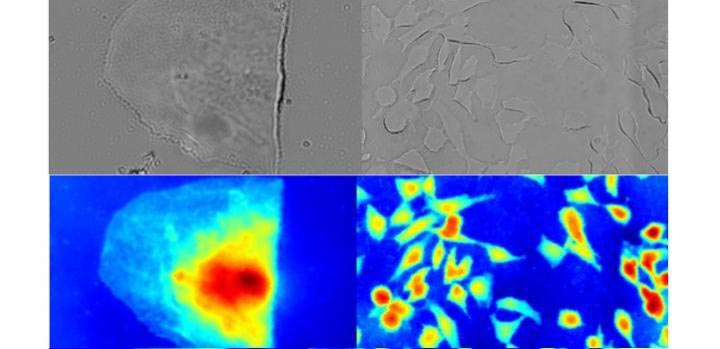Designer lens helps see the big picture

Quantitative phase images reveal more details than classical microscopy images. The KAUST technique captures both bright-field images (top) and phase images (bottom) in a single measurement. Credit: © 2019 KAUST
In its simplest form, microscopy creates an image of an object by measuring the intensity of light passing through it. This requires a sample that scatters and absorbs light in different ways. Many living cells, however, absorb very little visible light, meaning that there is only a small difference between light and dark regions, known as the contrast. This makes it difficult to see the finer detail.
But the light passing through the sample changes not only its intensity, but also its phase: the relative timing of the peaks in the optical wave. “Phase-contrast microscopy converts phase into larger amplitude variations and hence allows the viewing of fine, detailed transparent structures,” explains KAUST Ph.D. student Congli Wang.
Measuring the phase of light is trickier than measuring its intensity. Most phase-contrast microscopes must include a component that converts the phase change to a measurable intensity change. But this conversion is not precise; it only approximates the phase information.
Wang and his colleagues from the KAUST Visual Computing Center, under the supervision of Wolfgang Heidrich, a professor of computer science, have now developed a new method for quantitative phase and intensity imaging. Crucial to the performance of their microscope was an element known as a wavefront sensor. Wavefront sensors are custom-designed optical sensors that can encode the wavefront, or phase, information into intensity images.
The team designed an innovative high-resolution wavefront sensor, and the team members are now incorporating it into a commercial microscope to improve the performance of microscopy imaging. They then reconstructed the phase-contrast image using a computer algorithm they developed to numerically retrieved quantitative phase from an image pair: a calibration image obtained without the sample and a measurement image obtained with the sample in place.
This approach streamlines several aspects of microscopy. While other methods have achieved quantitative phase imaging in the past, they have required expensive or complicated setups, specialized light sources or a long time to generate the image. “Our method allows snapshot acquisition of high-resolution amplitude bright-field and accurate quantitative phase images via affordable simple optics, common white-light source and fast computations at video rates in real time,” says Heidrich. “It is the first time, to our knowledge, that all these advantages are combined into one technique.”
Media Contact
All latest news from the category: Interdisciplinary Research
News and developments from the field of interdisciplinary research.
Among other topics, you can find stimulating reports and articles related to microsystems, emotions research, futures research and stratospheric research.
Newest articles

First-of-its-kind study uses remote sensing to monitor plastic debris in rivers and lakes
Remote sensing creates a cost-effective solution to monitoring plastic pollution. A first-of-its-kind study from researchers at the University of Minnesota Twin Cities shows how remote sensing can help monitor and…

Laser-based artificial neuron mimics nerve cell functions at lightning speed
With a processing speed a billion times faster than nature, chip-based laser neuron could help advance AI tasks such as pattern recognition and sequence prediction. Researchers have developed a laser-based…

Optimising the processing of plastic waste
Just one look in the yellow bin reveals a colourful jumble of different types of plastic. However, the purer and more uniform plastic waste is, the easier it is to…



